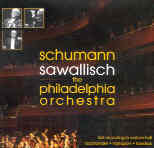As Wolfgang Sawallisch turns over the reins of the Philadelphia Orchestra to his colleague Christophe Eschenbach, he leaves behind this worthy memento of his devotion both to the orchestra and to Schumann. Now as we all know, Sawallisch’s set of Schumann symphonies for EMI has long stood as a reference edition, and its recent reissue in the Great Recordings of the Century series confirms that its reputation is well deserved. So we have to ask the question: Does this new set (which in addition to the symphonies includes fine performances of the Manfred Overture, Violin Concerto, five songs by Clara Schumann, and a fantastic rendition of the never-performed but marvelous Andante and Variations for two pianos, two cellos, and horn) tell us anything new about the music and/or Sawallisch’s view of it?
In short, the answer is “yes”, leaving aside for the moment the very different sonorities of the respective orchestras involved. Most gratifyingly, Sawallisch clearly hasn’t gotten especially slower and droopier over the years. In two instances where he does take more time–the first movement of the Fourth Symphony and the finale of the Third–the music does seem to hang fire when compared to the earlier versions. But in the three central movements of the latter work, Sawallisch is swifter, at times considerably so (the fourth movement), and he brings down the house at the end of the Fourth Symphony. The performances of the first two symphonies certainly stand with the finest available: the opening movement of the Spring Symphony has an extra rhythmic punch lacking in the earlier recording (not to mention an amazingly vivid but never annoying triangle), and the Adagio of the Second Symphony benefits from the passionate urgency of its quicker tempo.
But perhaps the biggest differences concern the two orchestras. The Staatskapelle Dresden performances are noteworthy for their extreme lightness and transparency (so important in this music). The Philadelphia’s darker, richer sound might be accounted a disadvantage, particularly with respect to the comparatively backward woodwind balances, were it not for the extra rhythmic impact of the timpani and brass. I’m not sure to what extent the acoustics of a fully populated Verizon Hall factor into the equation: certainly as live performances go these are well if not spectacularly recorded.
When all is said and done, my personal preference remains ever so slightly with Sawallisch’s earlier set (now a better value than ever), both for the Staatskapelle Dresden as well as for its greater overall consistency. But I’m also happy to have this newcomer for the very fine and interesting couplings as well as the really exceptional versions of the first two symphonies, which in the final analysis probably are a touch better than Sawallisch’s earlier ones. If you love this music you certainly can purchase this attractively produced three-disc collection safe in the knowledge that it is not just “more of the same”, but that it just as certainly sustains the very high standards that we have every right to expect from both orchestra and conductor. [Note: This set is available directly from the Philadelphia Orchestra: www.philorch.org.] [7/2/2003]
































